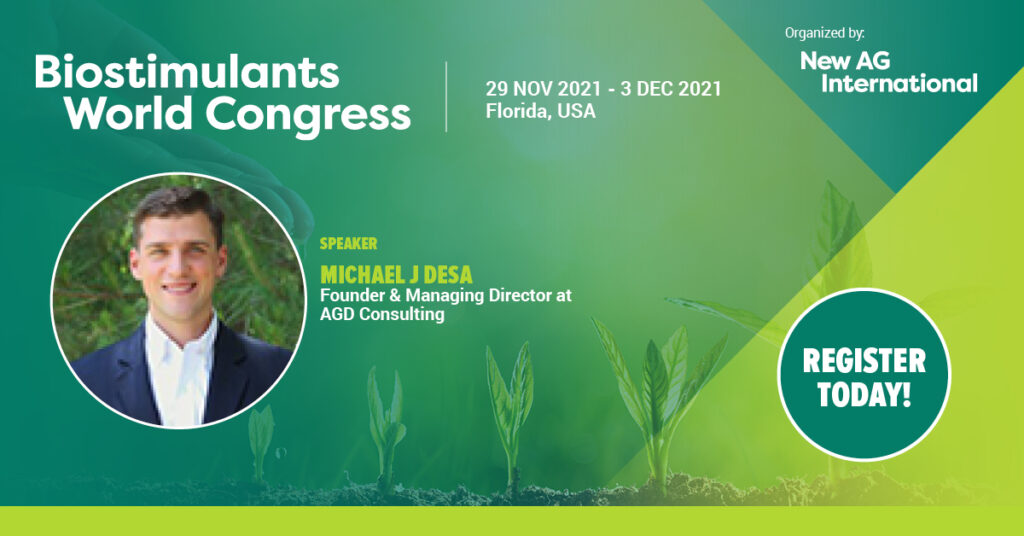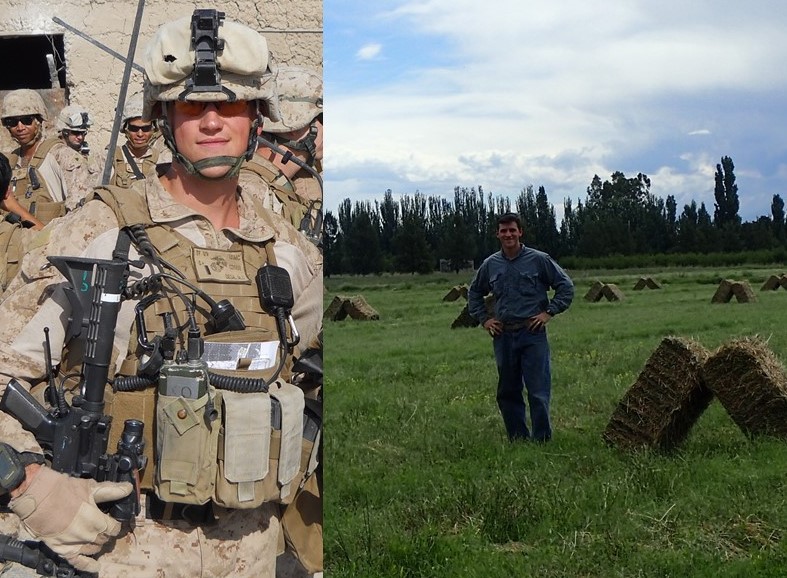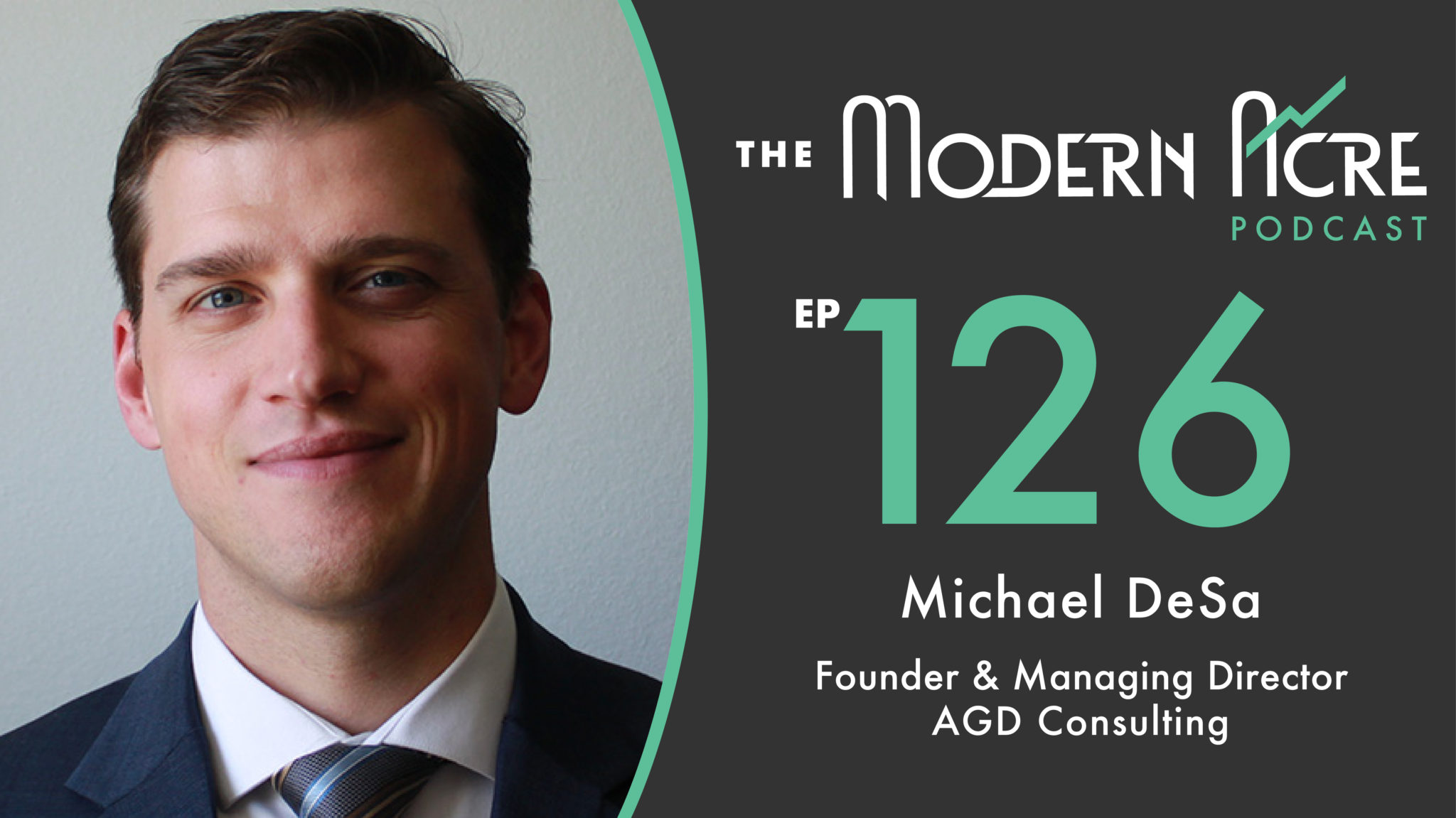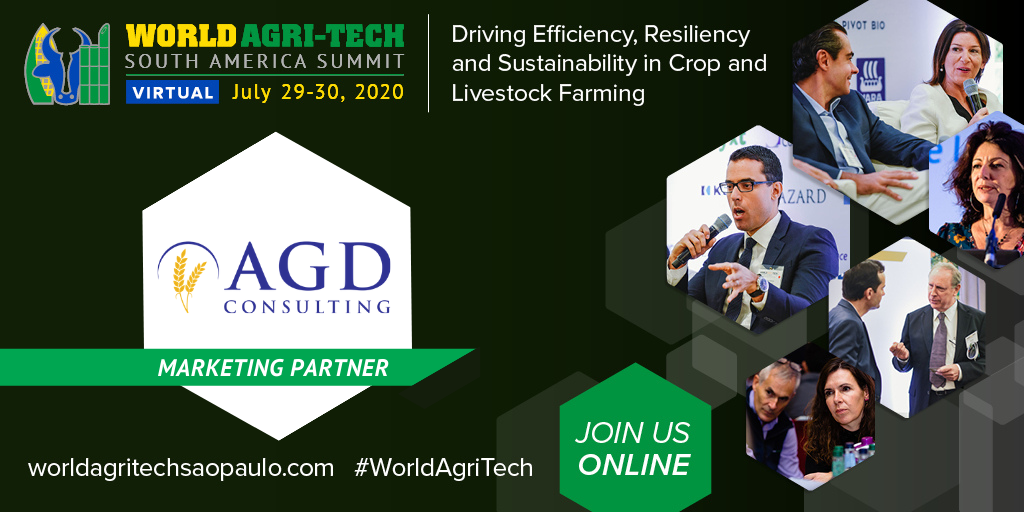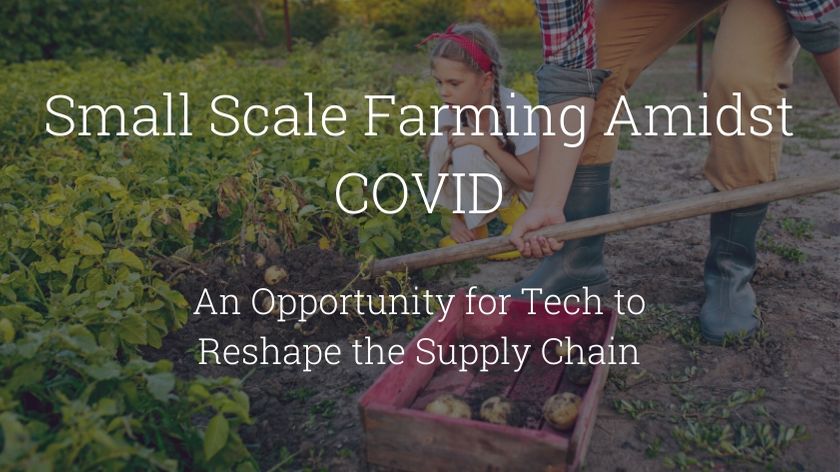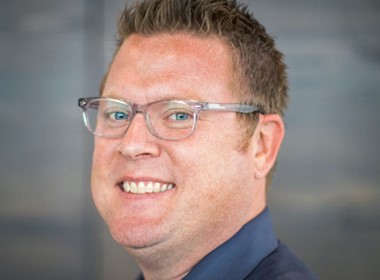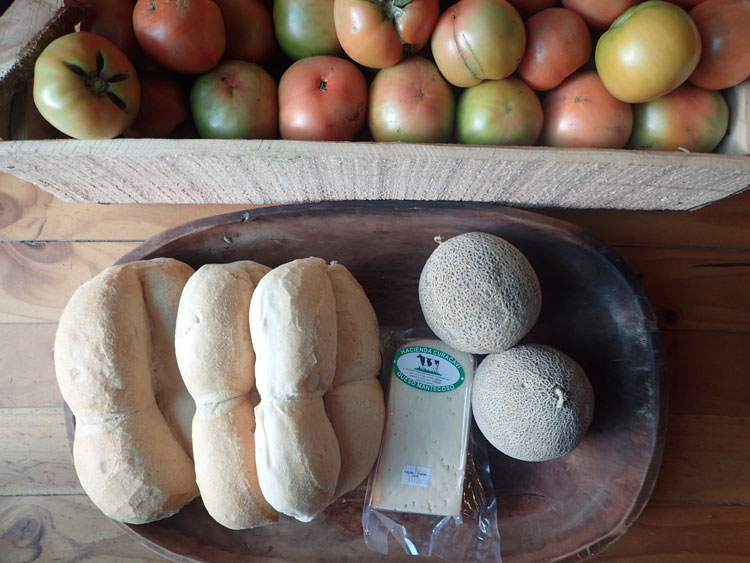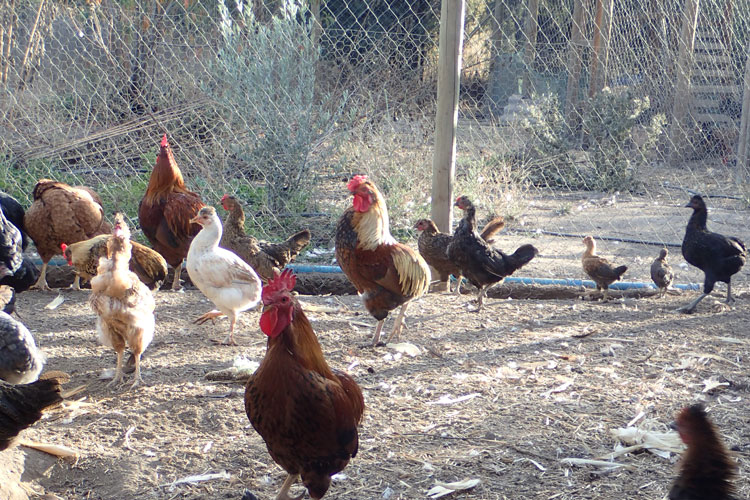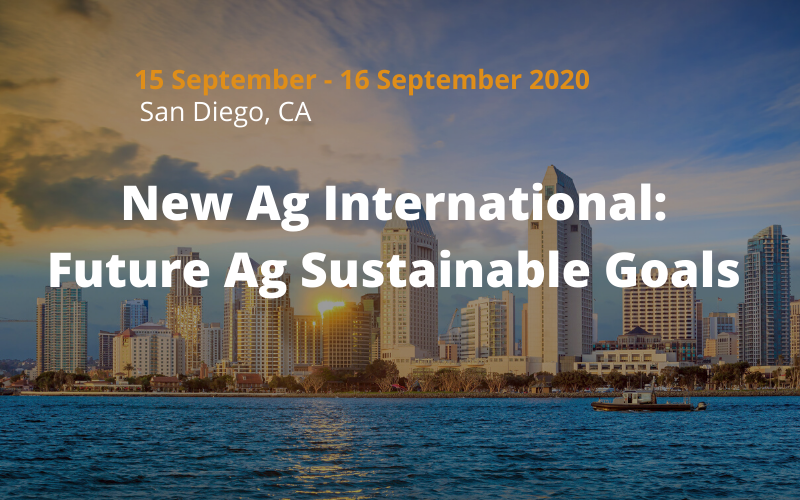On June 14th, 2021, AGD’s Founder/Managing Director, Michael DeSa, had the opportunity to host a panel discussion on behalf of New Ag International with two of the early adopters of regenerative agricultural practices – Dawn and Grant Breitreutz of Stoney Creek Farms. Below is a transcript of that fantastic discussion. Enjoy!
Mike DeSa 00:03
Good day everyone, thanks for joining us as part of New Ag International’s Digital Week focusing on sustainable and high tech ag. My name is Mike DeSa and I’m the Founder/Managing Director for AGD Consulting – a veteran-owned strategic advisory firm serving the global food, investment and agtech portion of the value chain.
Let me first start by thanking New Ag International for this opportunity and our guests for the willingness to share their time and insights on regenerative ag. Grant and Dawn Breitreutz are founders and Operators of Stoney Creek Farms in Redwood Falls, MN.
Over the past 20 years, Dawn and Grant have converted a conventional row crop and cow/calf operation into a multi-enterprise regenerative family business. In the late 1990s, after noticing degradation to their own lands, they begin to research and implement sustainable practices in an effort to increase production and improve yield, first. The soil health part of this discovery would come later. They were early pioneers into regenerative agricultural practices, and not without scrutiny. But they persisted and are now recognized as leaders in this space. In 2015, they were recognized as the Minnesota State Cattlemen’s Association Cattlemen of the Year. In 2016, they were recognized as regional honorees of the Environmental Stewardship Award Program and in 2019, their farm was featured in a multi-part docu-series produced by Farmer’s Footprint focused on holistic management practices.
Their 100%, no-till cropping system has evolved from a conventional corn and soybean rotation to a three (or more-crop rotation) annually, with the incorporation of cover crops whenever possible. Cattle are grazed across nearly every acre of the farm today every year and they’re using adaptive grazing throughout their pasture systems and now graze longer, with many more head than ever before.
Welcome Dawn and Grant, thank you for joining me:
Grant 02:07
Thanks for having us.
Mike DeSa 02:09
I was hoping we could start today’s discussion with your definition of what regenerative agriculture is, right? There’s often so much back and forth about the definition of this term and whether or not it’s appropriate or whether we go with sustainable or whatever the case may be. But let me get your take first and foremost on what you believe regenerative agriculture is?
Grant 02:34
Well, you brought up a term there – sustainable. Our good friend Gabe Brown says it this way, why would we sustain a broken system or degraded system? So, the way I define regenerative is basically any improvements we can see in soil health, whether it’s organic matter, water infiltration, all the way to a wildlife, healthier livestock or higher density in our grains, those are all things that we monitor and focus on to make sure we’re going the right way.
Dawn Breitkreutz 03:12
And it goes a little bit further to it. It lends to happiness in the family, you know, happiness and enjoyment and in what we’re doing. It’s a completely different way of farming now, and I don’t think we’d be here, if we wouldn’t have started down this path.
Mike DeSa 03:30
Why would we sustain a system that’s broken? Does that kind of mean that the current practices are somewhat broken?
Grant Breitkreutz 03:36
Well, I’ll just give you an example on our farm. Like you said in the intro in the early or in the late 90s, we figured out we had a problem here. We’re doing soil testing, and we were testing soils that are done the 1.6 and 1.9% organic matter. Organic matter is a measure of carbon. We all survive on carbon. And if you look back in history here, and I’ve got some neighbors that have some unbroken prairie, it tests at 12% organic matter. Well, in 150 years of farming, we blew, you know, 75 to 80% of it? Something’s wrong, something seriously wrong and we’re seeing all sorts of problems that others see right now in the industry. I mean, we had crop failures. We had sick cattle. It was just a multitude of things that we saw and then being married to her the eternal question of why why why why are we doing this? Why are we making a second pass of tillage? Why are you going on spraying again? You know, why are we running these cows thru the shoot again? And it always kept me thinking, and I mentioned we got to where we are, I mean, we’re by no means done. No, we every year we try something else and push harder and harder and harder.
Dawn Breitkreutz 04:59
I think that’s the farmer version of “if mama ain’t happy, ain’t nobody happy”.
Mike DeSa 05:10
You guys, this has been a third I think your kids now are the fourth generation farm. I mean, do you think it was – what was the tipping point there for you guys to finally say, something’s not right with the system? Was it someone like you, Dawn, that can kind of come in and ask the critical question, or was it finally at a point where it just wasn’t tenable anymore agronomically speaking?
Grant Breitkreutz 05:34
It was a combination of things. It was not paying the bank off at the end of the year. Yeah, we’d produce superior crops, we’d use all the latest and greatest technology, but there was no money left in our hands at the end. It was livestock health, that was a big part of it. We’re seeing all kinds of problems in the cattle. It was a lot of different things that pushed all at once. And some of it was just by chance. So, we were we were always running out of feed here for our livestock operation. And I started messing around after we cut corn silage off, I planted a cover crop in there, at that time, it was even called the cover crop, it was winter triticale. We’d plant it in there and the one year, we had rain, rain, rain, trying to harvest it you know, about a week ago, this time frame in Minnesota is when you harvest it. And it just kept raining and raining and raining and is getting so tall, we couldn’t get it through our harvesting equipment. And we had an inch and 43 hundredths one night, about two in the morning, when we got done feeding cattle in the morning, I told Dawn I said, you just got to go cut, we’ve got to get this stuff laid down to the ground and get it to the choppers or we’re never gonna be able to handle it. But she went and cut all day and never left the track. It was like “ding” – what just happened here? Why? You know, it was a trial of trial of different things for different reasons. And if you ever go through soil health academy, one of the main things they teach there is observation. And we were blessed enough to actually observe it and say, “Hey, something, something just changed here. Why? Why can we cut in the morning and eight hours later come through the choppers after that kind of rainfall never leave a track?” And right behind the choppers, we’re putting soybeans into the ground and had a wonderful soybean crop. You know, it was just things like that that hit us. The big side of it was eventually I studied grazing management and we were blessed to meet Ian Mitchell-Innes from South Africa and went through one of his classes, three-day classes. And we changed our grazing operations substantially. And it’s like, well, if we did this on the grazing land, why aren’t we focused on the cropland? If we made these huge changes out in pastures, why can’t we change where we’re producing grains?
Mike DeSa 08:00
Okay. So if I’m hearing you correctly, the first thing that you guys sort of tried in this was cover crop just a simple cover crop, but it wasn’t called that at the time. Was that to try to gain an additional revenue stream or was that to was that just kind of your first toe in the water as to what may happen if we if we put something like this down?
Grant Breitkreutz 08:21
Oh, initially, most all of them were for cattle feed. It was just a grow, grow three crops in two years, grow four crops in two years. Yeah, anything to grow more cattle feed. And you know, before we met Ian, we have been cover cropping on our farm for a long time before that, but had no knowledge of what we’re doing other than all of a sudden one year we’re not fighting cyst nematodes because we had a healthy turnip and radish crop after wheat crop. We didn’t even know we had cyst nematodes, you know, it’s just all these things that…
Dawn Breitkreutz 08:52
Instinctively we knew were, I mean, at the end of the year, you could tell that the cattle are what got the operation through. The cattle are what kept us going all through the years. And so we had to continually find ways, you know, to cut our costs to keep them alive. And, you know, it just happened that that was actually part of the circle of principles of soil health that we didn’t know we were doing at the time, that was actually benefiting us, you know, and we didn’t even know it.
Mike DeSa 09:25
You had mentioned both of you and you did a presentation a couple years ago as to just the way these practices, reduced input costs, and one of the examples that you gave was on vet bills. So, I’m curious as to what were those typical veterinary issues that you were having with cattle on the more conventional practices and then how did you start to see those problems fade as you moved into a more regenerative system?
Grant Breitkreutz 9:57
Well, we were we were calving out of sync with nature. We were calving in late February and March here in Minnesota, that’s not a good time to calve. So, we immediately had respiratory, intestinal issues and those cattle and those baby calves and fight that all summer and then get to respiratory issues again in the Fall. That was some of the main ones. I mean, you know, you bring that up, but I’ll never forget looking that up that one year, we spent $18,000 at the vet. And now with well over twice as many cattle, we’ll maybe spend $3,000 a year at the vet most of that is on vaccines that we just haven’t decided to give up yet. It’s not buying boxes of antibiotics, you know, cases of boxes of antibiotics anymore.
Mike DeSa 10:45
Were you guys giving any biotics those animals prophylactically before they were sick just to try to stave off some of those issues?
Grant Breitkreutz 10:54
Oh, yeah. early on. We did. Yeah. Early on in our feedlot days, we would run non-CTC through the feed on the first of every month.
Mike DeSa 11:02
You mentioned calving out of sync. Was that a result of trying to try to force production or forced calving at a at a time of the year that was more convenient for you guys? Like what do you mean when you say that?
Grant Breitkreutz 11:17
Well, you can’t calve of cows and plant corn same time. That’s the rule of thumb nationwide. Well, they’re wrong. You can. Our cows calved all during corn planting.
Dawn Breitkreutz 11:29
Yeah. It’s amazing they can have a calf without us standing by their side.
Mike DeSa 11:33
So, this idea was just to try to deconflict these two agricultural events for no other reason than just to free up time?
Grant Breitkreutz 11:42
Yeah. Well, we kept pushing our calving date up earlier and earlier to have bigger calves and sell in Fall. We were going after production, production, production. You know, when you sleep on a pickup beside a barn, you know, five or six nights a week? I don’t know what kind of fun that is. No, it was just stupid.
Dawn Breitkreutz 12:04
It was scary. You know, he’d be over here at the farm. We lived off the farm at that time, and he’d be over here. And I’d wake up in the middle of the night and he wasn’t there. And all I had is these, you know, horrible visions of him being attacked by a cow that was mad because he was helping her calves. And so then I’d be over here. And so neither one of us would get any sleep. And it just, that’s not a way to live your life. It’s just not.
Grant Breitkreutz 12:28
And we were, I will say this – My brother bought a set of cows that were May calving cows. And we figured out that those cows didn’t need any help. And then the good Lord wiped our pretty much our entire farm off the face of the earth in 2011. And we, at that time, we already had half of our cows calving in May and then it was just a matter of – we got to switch them all because we had no buildings left, we had no intentions of rebuilding.
Mike DeSa 12:57
Was it a rain or storm event? What caused that?
Grant Breitkreutz 12:59
It was 115 mile an hour winds with embedded tornadoes for 43 minutes. Not much stands after that
Mike DeSa 13:08
Was it both the grass and the structures that kind of resulted in that or was there animal loss of life too?
Dawn Breitkreutz 13:15
We lost a few.
Grant Breitkreutz 13:18
We lost a bunch of cattle in that storm. We had some in buildings that went down. Pretty much all we had left was our houses. They withstood the storm.
Mike DeSa 14:04
So then that became a moment for you guys to then say, look if we’re going to have to rebuild. Why don’t we try to rebuild this way?
Dawn Breitkreutz 14:14
Yep. God’s nudge.
Mike DeSa 13:28
In that same lecture, you guys described the converting of the mind that has to happen. And you talked about it specifically with this transition between conventional practices and regenerative practices. But why does that resonate so strongly with you all? That particular saying?
Grant Breitkreutz 13:53
As we were going down this path, converting things. I was born and raised farmer she was not. So when something would go wrong, I’d resort back immediately to what we’re doing before that worked. Instead of, you know, my first thought was to resort back to what worked instead of figuring out what the problem was with the issue we were having with our changes.
Dawn Breitkreutz 14:14
But the whole problem was, it didn’t necessarily work. It’s what they were used to. How they were raised.
Mike DeSa 15:46
Right. This adage of this is the way we’ve always done it, therefore, that’s the way we’re gonna continue to do it.
Grant Breitkreutz 14:26
Oh, man. But the hardest thing for me ever is planting corn in May. Here, everybody was done in April. You know, in this in this last weekend, our corn is just barely out of the ground. We’re just finishing planting soybeans today. And what happened last weekend? A big big chunk of the upper Midwest froze. Oh, no, all of a sudden, I look like the smart guy. At least I don’t have to do it twice.
Mike DeSa 14:55
Why were you guys? Why do you say that’s one of the hardest things to plant in later May instead of April, just because you don’t have the same length of growing cycle like you did in traditional methods?
Grant Breitkreutz 15:08
Oh, farming is a big competition.
Dawn Breitkreutz 15:10
It is but they’re also they’re also like herd animals. You see one going and all sudden you got the itch. And now you got it all. It is a little bit competition and it’s just a little bit – well, they’re doing it, so we should do it. So it’s hard to break out of that paradigm and then to deal with the fallout from, you know, from breaking away from that paradigm is also a little difficult – the social elements of that.
Mike DeSa 15:39
Yeah. Yeah, you and I talked about that, Dawn, I’m wondering if you can maybe kind of elaborate on that? From what I understand, I mean, you guys are kind of a blueberry in a tomato soup, so to speak, right? Where you’re, you’re surrounded kind of by more conventional practices, and you’re operating in an unconventional way for your own rationale and for your own reasons. But what’s that been like for you at the beginning? But then now I think just as importantly, what is it like today? I think there’s been some progression, but maybe walk us through a little bit of that.
Dawn Breitkreutz 16:15
I don’t know. At first, it was a little bit painful just because you kind of like you’re on an island all by yourself, but you are under a microscope too. Eventually you get you get used to that microscope, but it you it also keeps you on your toes, and that has you looking at your operation yourself and double checking to make sure you are doing things that you hoped to do. A lot of times we didn’t. But that’s learned. And eventually, you know, at first we separate kind of basically separated from everybody. We just we didn’t have things common things to talk about anymore. Um, but we eventually kind of got over that and we’re kind of tiptoeing back into our local society again and reacquainting ourselves with everybody and making sure that we’re open so that they can ask questions that their comfortable asking questions. And they are. And that’s encouraging to us. The fact that they’re curious and not just talking behind our backs makes us hopeful that people will start looking at this in a positive light, rather than in a competitive light.
Grant Breitkreutz 17:39
So, I’m the president of Minnesota State Cattlemen’s Association right now. 1,000 plus members. One of my interview questions was, “are you going to tell other farmers how to farm?” And I said, “Absolutely not and I answered that by – if you ever went and watched any of our presentations, I don’t tell people how to farm. I tell people how we’re farming what we’ve done wrong, you know, those types of things so they don’t have to financial hits and steps.” It still comes back to it’s all between your ears when you’re ready to chain you know, come and ask the questions. And for a while we had just shut down. And now we get neighbors coming and asking and we will tell them what we’re doing why we’re doing it.
Mike DeSa 18:24
You guys shut down in the sense that look – I’m just tired of this kind of scrutiny. We’re a closed book now. That kind of shut down?
Grant Breitkreutz 18:35
We’d plant something different, do something a little bit different than the neighbors. They’d come over and they’d ask what we were doing. We’d go through 100% of the explanation of why and then watch them do absolutely nothing after they understood it.
Mike DeSa 18:49
In your own instance, where you’ve got three generations of these conventional practices, and I can imagine the tomato soup around you, so to speak, is in a similar type longevity of these practices. How do you begin to have that discussion on converting? How do you reshape the thought process from one of competition to collaboration? Is there a place you always start?
Grant Breitkreutz 19:19
Yeah, um, I always start with try something. You’re never going to learn if you don’t try. And it comes back to us as humans. I mean, what’s the two hardest things to do? It’s to change and admit you’re wrong. If all of a sudden you quit plowing? In a way, that’s admitting you’re wrong. You know, and then the other part is all you’re going to change and switch to something else. I mean, it’s human nature besides generational teachings. Besides so we always encourage people to just try something. Now in saying that, if you Michael, were farming, what I would call full bore conventional, and you wanted to convert what we’re doing, I will tell you hold the brakes. If you switch everything to what we’re doing in one year, it will be a complete failure. Soils are addicted to what we’ve done them for the last 75 years. They need to be weaned off, they need to be nursed back to health, you know, so there’s steps and there’s processes to it. But there’s all sorts YouTubes, there’s all kinds of seminars, there’s all kinds of people, right and local areas that you can go ask – how’d you get this far? What was your steps and methods to get there?
Mike DeSa 20:32
That’s such a great point. That it it’s an incremental change, from what I think I’m hearing you say. That if you just start somewhere, that somewhere is going to be different for everybody, based off of what you’ve done, where you are, what your geographic and financial limitations and requirements may be, but start somewhere. And I mean, you guys, if I’m understanding you correctly, started with cover crop, is that a fairly reasonable place, generally speaking, for folks to start? Or no till or strip till?
Grant Breitkreutz 21:08
Reduce tillage and a cover crop
Mike DeSa 21:15
And in terms of, you know, capital expenditure to begin to do those things – I know there’s special equipment for strip till, but if you can, are there are there ways of implementing lower till without buying, you know, lots of different or new equipment, or the ways you can do that with your conventional equipment?
Grant Breitkreutz 21:42
At least in our area there is. A lot of the co-ops that we buy our inputs from have no-till seeders. We’ve got a lot of neighbors that have the co-op come in and seed their beans for them. You know, that’s one step. Now, a bunch of these co-ops are starting to seed cover crops in the Fall to keep that piece of equipment making money for the co-op. There’s farmers, farmers could figure out how to do it. But when you bring up strip-till, and those types of things, we got a friend not too far away from us here. He, he understood soil health, got a grasp of it, spent the entire winter studying it for a while, probably for many years. And when he was done, he bought a strip-till machine, he bought a vertical tillage machine, and sold $1.8 million worth of machinery over and above what he spent buying those two pieces of equipment. And if you talk to the man today, he’ll never turn around and go back. Imagine that – $1.8 million of equity freed up plus got rid of the massive workforce needed to run all that equipment.
Mike DeSa 22:46
Because we’re talking about some of these different practices, I want to make sure that we talk about some of these principles that you guys have described in previous lectures. And I think you mentioned six in particular, I’ve got those six here, but if you would kind of detail those out for us, kind of what are those basic six principles that you guys use that have sort of shaped your regenerative practices?
Grant Breitkreutz 23:13
Now the first is Do Not Disturb. That was our toughest part. The corn was the last one we switched to no-till. And we had a plan that if no-till didn’t work for us, we were going to stretch back to strip tilling for corn. But we had perfected planting all the other grains no-till so – do not disturb. You know, the second one I mentioned that I don’t think we’re given enough credit is Build Cover and armor on that soil. We’ve over grazed pastures here because we’ve been extremely wet, couldn’t use some. And that covers missing. We got weeds coming in this year. You know, we got weeds coming in, we’re gonna spend all year building a cover back on these pastors. And it goes right direct to the cropland too. How can a weed germinate if it can’t see the sun? If there’s enough cover on the soil, that weed is not going to germinate.
Dawn Breitkreutz 24:10
And then Diversity is a huge part of all of it. That’s why we have the cattle across all acres. So not only do we have, you know, all the different livestock, we have hogs and cattle. Now we have chickens. But also when you have all the diverse plants out there, you’re building an environment where there insects and birds and wildlife also. So the more diversity you provide, the more diversity you draw, you know, to your to your farm, and it creates a bigger circle of life, you know, on your operation.
Grant Breitkreutz 24:51
And Keep a Living Root in the Soil all the time. Obviously here in Minnesota, it’s tough for us but we figured out how to do it. Ok, so we terminate cover crops when we planted the corn, the corns that are growing, keeping the biological life going. This next week now we’ll start inter-seeding annual rye, radishes, turnips, kale, some other stuff in between the corn rows so what then the corn starts dying, we still got to living root growing all the way till the end of the season. You know, that’s what we figured out, you know, and soybeans we don’t do that. We come in right after the soybean crop is off and seed a bunch of cover crops in there.
Dawn Breitkreutz 25:36
Then Incorporating Livestock. That’s really important. And I know that there’s a lot of row croppers out there that have livestock, and they don’t want to put livestock on their farms. And that’s fine. All of this can be done without having livestock on your acres, but the livestock part of it just kind of speeds it up. And I think that strictly row crop producers and livestock producers can cooperate and work together to get that to happen and to do it properly. And that’s helped heal things here on the farm faster than we could have imagined. But I think the biggest the biggest one that that we’ve been and they brought in is the principle of Context. Each operation has a different context. And everything that you do has to be within your context. So, what we do here on Stoney Creek Farm is not going to work on somebody else’s operation. We’re further along we do different things. We have different goals. You know, we have different people involved. So, you have to find out what works in your context. And each field has its own context. So there isn’t an easy button for this. Yeah. And I think that’s one thing that keeps really interesting. You do not get bored ever, ever.
Grant Breitkreutz 27:03
And we get we’ve got a really good friend we just went on to help marry one of his kids off and he and his boys farm with him. They wanted a prescription they wanted a recipe of what to do. I cannot do that. You are three hours north of me. You got different equipment, you run your cattle different times of the year, you’ve got different cropping rotations, you know, they wanted a prescription. And they’ve been asking for that for the last 10 years, right? And I said, No. I said you need to come to a school or come down to my place and look and see what we’re doing implementing at their place. It was just neat being up there this weekend to see how far they’ve made it. Like Don said, they did it in their own context, what they were comfortable with, financially wise, you know, and it was, like Don said, there’s no ease.
Mike DeSa 27:37
Give us a sense of why this pattern is circular, and why it works in a sustainable and regenerative way.
Grant Breitkreutz 27:47
Because look at Mother Nature, is it ever in a set system? You know, like I say, we just froze here the other day? Well, that’s not common. Rainfall patterns are shifting all the time. Nothing in Mother Nature is the same all the time. And, and we’re very fortunate to finally realize that here on the farm, we’re managing and ecosystem. Dr. Allen Williams has been awesome to teach us this. There’s compound cascading effects. And they’re always either positive or negative. But disruption is good. So in our in our grazing, or even in our cropping fields, we don’t do things the same two years in a row or a cycle of five years in a row, just because disruption is good. Like I said, we over graze some pastures, we know we need to rest them longer this year to get the to get the biomass back up there. You know, if we have a crop failure in a row crop field, we need to get something going out there or an extreme drought or something that prevents us having cover on the soil, we need to get something out there and get that crank and we need to fix we need to fix the six principles and realize that we’re managing an ecosystem. And the grazing heights and stuff of grasses that. For a long time we had Department of Natural Resources here wanting to change some land to warm season grasses, so graze all the cool seasons off, graze all the cool seasons off, graze it short, graze it short. Well, when you’re only focused on one thing, you can’t imagine the disaster you have by just focusing on those warm season grasses. It was horrible. Yeah, they got some warm season grasses, but you have to watch, you have to observe everything and realize that you’re managing an ecosystem.
Dawn Breitkreutz 29:41
I think I need to say that, this probably to some people, it sounds really complicated and really hard. But once over the hurdle of looking at it from that lens, you actually realize that it gives us a lot of flexibility and that’s a positive. That’s a huge positive. Everything we do gives us flexibility because we have the livestock. That’s the flexible part of it.
Grant Breitkreutz 30:16
Two springs ago we’re calving with nature. And we can’t have by our crest time of the year, so we have on our flat land. And we had grazed all of our flatland. We were out of feed. Dawn and I were standing on the hill at the end of the driveway here, and we’re like, what are we gonna do? There’s nobody around here that’s got feed. And she looks at me and she’s like, “well, what the hell’s wrong with that rye field behind us?” Well, here, there’s a cover crop of rye that’s 18 inches tall already. All we did was walk the cows across the road, okay, kept them there for a couple weeks and all of a sudden a grass again, you know, it just, that’s just one example of the flexibility that we get, by doing things so much different.
Mike DeSa 30:58
This kind of picture and phrase is circulating in my mind now of managing an ecosystem where you’re permitting diversity, but you’re almost doing it in paddocks. so to speak, right? You’re allowing the livestock to move and operate in a particular paddock where their manure and their urea goes back down in the soil as fertilizer, maybe you pass hogs behind it, maybe you pass chickens behind it to kind of spread it all back out again. And then you take that whole system, and you move it to the next paddock, or you move it across the street to the rye field that hadn’t originally maybe been a part of your diversity management, so to speak, but Mother Nature gave you an opportunity. And you capitalize on it because you had the mindset and the flexibility to adapt to what was being presented to you.
Grant Breitkreutz 32:05
You said it very well. I guess it’s gotten to the point…how do I say this? Twenty-five years ago when Dawn and I started, if you’d have told us we were going to win conservation awards, we would have said no, we’re not the tree huggers in the neighborhood. We don’t want that. Now, after the first award in 2010, and we realized what we’re doing, we can’t work hard enough to do this. You know, we used to fight mud holes on this farm in the pastures or in the tillable land. We don’t fight that anymore. We don’t fight moisture extremes. And for the most part, we don’t fight moisture stress. I mean, there’ll be they’ll still get us but it’ll be after the neighbors get burnt up first, but just watching what’s happening out there, you know, we’ve been taught to observe, observe, observe all the wildlife, the insects, the birds, the it’s just unbelievable. That we actually affect that through our management.
Mike DeSa 33:08
Since you mentioned not fighting this, I’ve got to ask – what are you fighting now? What has switching to regenerative practices, what challenges have arisen that are either constant or consistent? Everybody has challenges in any profession. What are yours is as regenerative practitioners?
Dawn Breitkreutz 33:39
Dandelions.
Mike DeSa 33:42
What do you mean by that? What do you mean by that dandelions comment?
Grant Breitkreutz 33:46
I’m the best dandelion farmer in the county
Mike DeSa 33:52
They just have no value
Grant Breitkreutz 39:54
As we made all these shifts and changed all these practices, we just weren’t watching the dandelions. I never knew how bad it could be. But you know, that’s in a row crop side of it. But we’ve got that under control now.
Mike DeSa 34:07
How are you controlling that?
Grant Breitkreutz 34:10
With herbicide
Mike DeSa 34:11
Okay
Grant Breitkreutz 34:11
We’re coming out with herbicide. We are not we’re not organic. We just with organics, I’m letting some of my friends figured out how to do no-till organic first, and then hopefully we can feed off of their lessons learned doing it and get ourselves to it. But the biggest challenge right now on our farm is getting the hell out of the commodity market. We so desperately don’t want to sell corn into the commodity market. We don’t sell anything in the commodity market. We found a lot of places to get out of that and get on our own. But we have been picking up a bunch more land. And so we’re going to be in the commodity market again this year a little bit. But you know, we’re growing non-GMO soybeans. And we’ve got a grain terminal just two miles or three miles away from us as paying us 80 to a buck 20 over market value. Now, I’m out of the commodity market. You know, plus I’m getting a premium. This Fall, we’re going to take a bunch of our open pollinated corn and make it into chips. And we can make a good chip and market chips. You know, we got we got friend is doing he said that’s 30 bucks a bushel net. Well, good Lord, how many bushels of corn do I got to raise at $30 a bushel net? Well, maybe I’ll have a machine shed full of chips. But we’re, you know, we planted some red fife wheat this year, the kids want to mill that and sell flour. You know, that’s the old heritage breed wheat. It’s all that type of stuff that we’re just trying to get away from the commodity market so we can control all the end prices. You know, we planted a bunch, we planted a bunch of seven grain mix last year that turned out awesome. I planted a bunch more this year. Well, that seven green mix is the perfect chicken ration year-round all by itself, I don’t have to buy any inputs off the farm. You know, I still buy some supplementation, but I’m not buying soybean meal anymore. And there’s customers that don’t want soy in anything, you know, it’s just those type of things that we’re struggling to find them. That’s our biggest challenge. And obviously, I’m pushing our soil to maximum health faster than we are. And we fought some awful wet years up here and didn’t make much progress but this is just a treat. Cody, my son-in-law, he’s out planting beans right, you know, just thinking the biomass that’s gonna lay down tomorrow or whenever we go through with the roller cramp now, just amazing how when Mother Nature helps us out a little bit we can get cover back on that soil again.
Mike DeSa 36:57
One of the challenges is pushing soil health to an optimum space faster. Right. So if I’m kind of understanding that correctly, one of those challenges is repair in a faster way than what may be conventional. Are there practices you guys are using that have you found some success with as to making that regenerative process for the soil faster?
Grant Breitkreutz 37:35
Yeah. Cover crops and like I say the last four years we’ve really struggled getting cover crops even putting on time and then throws off early or later. That really sets up but if we’ve got a successful cover crop life is really good for Grant. I mean like this year, you plant corn and a bunch of stuff. But plant corn, we spray is three days later we’re done for the year. We’ll go out and apply some nitrogen. But that’s it. No more herbicide, no cultivation, just get the cover crop interceded in there.
Mike DeSa 38:14
Say that again. So with a cover crop down, you plant no-till into it. You do one pass herbicide early, you maybe do a later shot of nitrogen. That’s it til harvest?
Grant Breitkreutz 38:31
That’s right. Intercede our cover crop and we’re done until harvest. We’ve even gotten that working on soybeans. Where Cody’s planting today, that’ll be a one pass system on soybeans. I sprayed it yesterday to kill the rye and the dandelions that we had in there. And we will not have to re spray that this summer and they will be the cleanest beans in the community. And they’re non-GMO.
Dawn Breitkreutz 38:54
And we don’t need any fungicides and no insecticides on any of our acres.
Mike DeSa 39:00
I was going to ask how you’re controlling pests without pesticides.
Grant Breitkreutz 39:08
Rotation.
Mike DeSa 39:10
That’s it, rotation?
Grant Breitkreutz 39:11
Rotation, rotation. All of our corn that we plant has no seed treatments on it at all. No neos, no fungicides, no nothing. It’s it looks like corn. We’ve got a bag of corn left over we can feed it’s to the cattle or hogs
Dawn Breitkreutz 39:26
It’s not pink or green or blue.
Mike DeSa 39:28
Right. That’s what I’m thinking so the rotation of the crop in that particular paddock or field where you’re planting in and of itself through your positive or beneficial nematodes in the soil actually performs pest management for you. Or/and the biological insects that As a result of that diversity that are natural predators.
Grant Breitkreutz 39:51
Well, basically when you look at it, we’ve broken the cycle. If you’re just corn on corn, you got a compounding increase in harmful insects. above and below the soil. We offer habitat for beneficial insects, maybe not in that field, but in a bordering field or on a part of the farm. Where instead of in Minnesota here in August, the spray planes run non-stop spraying for soybean aphids was sprayed for soybean aphids, and eight or nine years, you open up our bean canopy and it’s just full of freakish insect life that’s eaten those aphids. Do we have aphids? Yes, but never economic threshold where we have to spray, you know, we’ve created the environment where the beneficial insects can be there. I think as Gabe Brown, one of those guys had a slide years ago, it really caught my eye – every time we go after, say that soybean aphid with the plane and insecticide we kill 1,700 beneficial insects. Well, we’ve given them the habitat and we don’t kill them. So they’re here, they’re our friends.
Mike DeSa 41:10
To our earlier point about mindset, right, that’s just you just changing this sense of the presence of insects, right as being something that can be beneficial, instead of something that is a detriment to the crop itself is just such a foundational shift in the way you look at it as a system. One of the things that I’m hearing you describe as a challenge is finding those kind of value-added opportunities, where you’re growing a particular corn variety that you can make a chip out of whether you’re, you know, taking something else and turning it into something with a higher premium, with a little bit of extra value-add, etc. Do you do you see your path to growth and the future as one of either scaling these opportunities that you’ve already found through more land and the similar practices? Or do you see it as a culmination of lots of different value-added opportunities where you have 20 or 25 instead of four or five on double the acreage?
Dawn Breitkreutz 42:42
Well, the simple answer would be four or five on all the acres, but, you know, it’s hard to say right now. In that regard, it’s early times for us. You know, we haven’t spent a lot of time focusing on that part of things because of other things that you know, we’ve had going on that you know, we’re shutting doors right now. But they’re not shut yet. So we have an opportunity to look into it and spend the time to do that. But bringing our daughter Carly and Cody on the operation and having them do the direct marketing; they are opening doors like crazy. And so we’re you know combined between the two of us among the four of us we’re working through those steps.
Mike DeSa 43:33
What type of doors have you shut?
Grant Breitkreutz 43:36
Years ago, when we weren’t making ends meet, we decided to buy a baling business. And you want to run your life into the ground, go bale 40,000 bales of corn stocks every Fall. You know, I added it up, after 10 years we put 49,800 hours on equipment. What the hell for, you know? 50,000 hours on equipment, pay all that help, all the labor? You know, so we’re just we’re just finishing up getting all the property cleaned up and out of here and that’s taken too much work to get that stuff. But we got to get it out and then we get on with what we’re doing.
Mike DeSa 44:18
Yeah, and I can certainly respect that. I appreciate you sharing that first of all, but Dawn I can certainly respect the kind of uncertainty of what the growth future of Stony Creek farms looks like. That’s always one of the big questions, I think is that are these regenerative practices? scalable? Can you can you take them on to more acreage? And I don’t know, if just maybe in the form of the question that I just asked, it sounds like you can, it’s just a matter of doing it in the context in which you’re operating? Because it’s so important. Right? I have to ask, right? Because I think there’s so much chatter about it. Now, I want to see if it resonates with you all – carbon markets? Are these I know, and I won’t ask you about regenerative or I won’t ask you about impossible or lab grown meat? I just I don’t think that’s quite relevant here. But I will ask you about carbon markets? Are these an additional revenue stream? Or are they a bridge too far? How are you viewing that?
Grant Breitkreutz 45:28
My view on that is they are additional revenue stream for farmers. But once again, the middleman is taken way too damn much out of the pie. You know, it’s just like I said, I want to get out of the commodity market. Why? Because they’re making all the money, you know, right now on cattle, they’re making over $1,000 a head? Well, if we get out of that market, that’s money, maybe not all money in our pocket, but at least a good chunk of it’s in our pocket. I’m afraid this carbon market is being set-up very similar. And some of the contracts that I’ve looked into are scary. You know, they’re asking for 20-year commitments on some of these farms for some of these programs. That’s, to me, the way our farm has evolved and changed so rapidly from year to year, in the last 10 years, in the last 20 years, why would I lock myself into something for 20 years, and the other part of the carbon market is – they ain’t gonna pay me jack for what we’ve already done. These carbon markets are going to be focused on the guys that are trying to get him to do no-till or cover crops, and those guys will probably the biggest rewards out of it. Now, if all of a sudden that carbon market falls apart again, are they gonna affect their old practices because there’s no subsidy? I would just about guarantee it.
Dawn Breitkreutz 46:54
But let’s go back. You said you wanted to avoid the Impossible Burger question?
Mike DeSa 47:00
Yeah. No, tackle it, Let’s go.
Dawn Breitkreutz 47:04
Okay, so there’s a company up-state a little ways, and we are growing peas for that company. And the reason why is because it fits our context. Those peas, yeah, their vegetable protein, and I don’t care what they’re going to do with them. They if they want to compete against our beef, that’s fine. People want to eat it, that’s fine. That’s your choice. But it fits our context because those peas go in early, they come off early. And then we have the opportunity to go back in and plant cover crops and run our cattle across those acres. And it’s helped us heal our system. So why wouldn’t we take advantage of that? We’re getting a decent price for them
Mike DeSa 47:52
Yeah, that’s so that’s… go ahead Grant.
Grant Breitkreutz 47:55
They’re not competitive with soybeans right now. I mean, I’m sure our neighbors are saying what hell Why did you do that? Why not? We’ve got so many acres of corn, we’ve got so many acres of soy that we’re getting a good price on, if we market it correctly, obviously things are very hot. To me, this was the time to find out how to grow these other crops. You know, we got high corn and soybean prices. I don’t need to get rich all at once. But I know corn is going back to three bucks. And I want to know how to grow yellow field peas for Puris potentially going into a vegetable protein market that competes with our beef. But I’ll harvest these peas the end of July. If we get moisture and successful cover crop on there, I will grow corn on there next year for just about nothing. There will be virtually the only synthetic input will be a tiny dash of nitrogen. Well then when corn is $3 and I’m producing corn for $2.50, I’m still making money. We got a look at the whole system. You know and that’s, that’s why we’re doing this.
Mike DeSa 49:03
Yeah, but I mean, the for the forthrightness that it takes to think about growing something for a competitor to your own product, so to speak. I mean, again, we’re kind of back to mindset shift here. Where, yeah, you can grow these and… go ahead
Dawn Breitkreutz 49:25
They’re not our competitors. They really aren’t. We know that our that we’ve got good quality beef. In the in the system, yeah, maybe. But we know that, you know, we’re confident that the eating experience and the flavor and the nutritional value and all of that, the whole processed system. It doesn’t compare, they don’t compare.
Grant Breitkreutz 49:50
And this company was in this long before the Impossible Burger came. I mean, they’re a storied company. I’ve met the owners. I mean, we really like the company.
Mike DeSa 50:00
Let me ask you one final question, if I could. Dawn, you mentioned in one of our first interviews that adopting these practices has brought joy kind of back into and I Grant I think that may be the case for you as well, but joy back into the practice of agriculture, rather than one of competition. Describe if you could kind of your thoughts around that sense of joy that’s come back with these practices versus maybe what your mentality was prior to that.
Dawn Breitkreutz 50:44
I think…a friend Gabe has put it really well, rather than getting up in the morning and trying to figure out what you’re going to kill that day, you go outside, and you observe all that you have here and all that you’ve helped create, and what life you can bring to the farm now, and what life you’re going to see as you’re, you know, going around and seeing the improvements that you’ve made, rather than Oh my God, we’ve got a weed, we’ve got to kill it. What are we going to spray? All those things. It’s just it’s living positively. For the moment. I mean, yeah, we have bad days. But this is so much more uplifting and being able to be a part of it and to see it and to look through, you know, God’s eyes. You know what, what we see out there that that He’s given us and that we can remove it rather than keep on degrading it. It’s refilling. It really is.
Grant Breitkreutz 51:52
Just a simple example today we just got done loading Cody up with seed to go and seed it and Carly was walking by and she’s like, what is going on that field? Where’s all that smoke and dust coming from? we all looked out there. Here the pollen coming off of that rye. It looked like a dust storm. So we were just talking about this we got we’ve got dust in the air from our conventionally tilled neighbors fields. We’ve got pollen blown air, I mean what’s pollen gonna hurt other Cody’s like, I’m gonna die, I’m just going to go inside right now I got allergies. But you know, it’s just fun. It’s just fun things like that, that we get to see now that where before. If we were standing in the exact same spot, the way we farmed 20 years ago, we’d have been worried about dirt ball, instead of a big pollen cloud going across the farm, you know. It’s just daily and weekly things like that all the time.
Mike DeSa 53:00
And I bet you guys could at this point could fill a book with those tangible examples. Because it in my mind, those are, those are key moments to sort of capture and try to articulate. So I’m glad you shared that Grant because I think that shows, in my mind two things: It shows how your perspective on something can change. If you’ve if you if you’re looking at it through a different lens. But then I think it also shows it shows the way that these the system should operate. That’s what happens when wind blows on plants that are flowering is that their pollen spreads for a natural reason. I don’t know. I don’t know if that example speaks to the rest of the folks listening, but it sure speaks to me. Is there anything else that I’m not asking you about regenerative agricultural practices that I should be that you want us to know?
Grant Breitkreutz 54:03
I guess the big thing is for farmers that are thinking about pursuing regenerative agriculture, it should not…a cover crop should not cost you money – long term. There might be a short term upfront expense, I mean, changing practices should not cost you money. There might be a short-term upfront expense, but eventually the returns come back, you know, like here with us with the cattle, it really helped us a lot because we could plant a cover crop we could graze it. Well, if you’re just a corn and soybean farmer, you’re not going to see that type of return right away, but increase in soil health and water infiltration, the nutrient replenishment, it’ll come eventually in reducing synthetic inputs, you know. And really, as a society, we need to look at this, you know, two years ago, we tried going down I-29 three times and it was closed for flooding. You know, in our farm, where we’re at eight to 12 inch rainfall infiltration rates, and I can step right across the fence and a half to eight tenths of an inch in an hour. You know that regenerative agriculture is more than just our economic and social life here on the farm. It can heal a nation, you know, Dr. Alan Williams, he’s a very, very smart man, when Hurricane Harvey hit down there in Texas, I was on the phone with him for something and he was in his hotel room. He’d done the calculations, if every farmer and rancher in that region had increased organic matter by 2%, there’d been no flooding. Look, increased organic matters here four and 5%. Already in a short period of time. I mean, it can be done, we can heal, and we can fix a lot of the stuff we deal with other than an agriculture.
Mike DeSa 55:51
That’s a great way to end is that there are…you talked about second and third order effects of actions beyond what we intend to. And those I think, largely speaking can be positive, within regenerative agricultural practices beyond just what we’re doing for our pocketbooks or for our livelihood. But to fix things around us. So,I’m just I’m so grateful for the both of you for what you’ve done, for what you are doing the education and encouragement that you’re providing others in this space. I hope that you continue to do it for decades more and that your kids and your son-in- law continue to do it as well. So thank you guys so much for taking the time and for being a part of this discussion.
